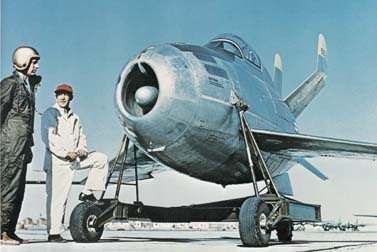- XF-85 Goblin
infobox Aircraft
name =XF-85 Goblin
type =Parasite Fighter
manufacturer =McDonnell 
caption =XF-85 Goblin
designer =
first flight =23 August 1948
introduced =
retired =
status =Cancelled 1949
primary user =
more users =
produced =
number built =2
unit cost =US$3.1 million for the programKnaack, Marcelle Size. "Encyclopedia of US Air Force Aircraft and Missile Systems: Volume 1 Post-World War II Fighters 1945-1973". Washington, DC: Office of Air Force History, 1978. ISBN 0-912799-59-5.]
variants with their own articles =The McDonnell XF-85 Goblin was a
fighter aircraft , conceived duringWorld War II and intended to be carried in thebomb bay of the giantConvair B-36 bomber as a defensive "parasite fighter ." Because of its small and rotund appearance, it was nicknamed "The Flying Egg."Design and development
The McDonnell XF-85 Goblin was designed to meet a USAAF requirement for a single-seat "parasite" escort fighter that could be carried by a large bomber. Development of two prototypes was ordered in March 1947. The resulting design was entirely the product of design constraints, which required it to fit into the bomb bay of a B-36 (although it was first tested under a B-29). The B-36 was the intended mother ship that would carry as many as three Goblins.
A tiny, short fuselage was fitted with low/mid-set foldable swept wings, of 21 ft 1.5 in (6.44 m) span. It was powered by a Westinghouse J34-WE-7 turbojet, of 3,000 lb. (1,361 kg) thrust. There was no landing gear except for emergency skids. The fighter was intended to return to the parent aircraft and dock with a trapeze, by means of a retracting hook.
Operational history
McDonnell built two Goblin prototypes (USAF Serial no. #46-523 and #46-524). During wind tunnel testing at
Moffett Field , California, the first prototype XF-85 was damaged. Consequently, it was the second aircraft that was used for the initial flight trials; its first flight was on 23 August 1948. As a prototype B-36 was unavailable, all XF-85 flight tests were carried out using a converted Boeing EB-29 Superfortress parent ship. On the first flight, after a little over two hours it became obvious that turbulence around the bomber created difficult control problems. In flight, the tiny fighter was stable, easy to fly and recovered well from spins.Baugher, Joe. [http://home.att.net/~jbaugher1/p85.html "XF-85 Goblin"] . Updated 23 October 1999.] However, many pilots found it difficult to hook the Goblin to its bomber's trapeze.Termination of the XF-85 program in mid-1949 was the result of a number of factors:
# Docking with the bomber "host" proved much more difficult than thought; even experienced test pilots had trouble. (On the other hand,Chuck Yeager stated that the XF-85 test pilot was particularly incapable of formation flying.Yeager and Janos 1986, p. 226.] )
# The XF-85 was no match for the conventional enemy fighters it would have to engage to defend the bombers - it was slower and much more lightly armed.
# The increasing range of jet escort fighters (along with the advent of in-flight refuelling) allowed them to accompany bombers on their full missions.
# Tight budgets meant that less important programs such as the XF-85 were canceled.Later, a B-36 was used as a mother ship for similar tests, carrying a conventional Republic
F-84 Thunderstreak fighter. These tests, known as FICON (Fighter Conveyor) experiments, were also found to be of little long term practical use and the whole concept was dropped.urvivors
Two prototypes were built, and both still survive: #46-523 in the
National Museum of the United States Air Force atWright-Patterson Air Force Base nearDayton, Ohio and #46-524 at theStrategic Air and Space Museum inAshland, Nebraska .pecifications (XF-85)
aircraft specifications
plane or copter?=plane
jet or prop?=jet
crew=1
length main=14 ft 10 in
length alt=4.5 m
span main=21 ft 1 in
span alt=6.4 m
height main=8 ft 3 in
height alt=2.5 m
area main=90 ft²
area alt=8.3 m²empty weight main=3,740 lb
empty weight alt=1,696 kg
loaded weight main=4,550 lb
loaded weight alt=2,063 kg
max takeoff weight main= lb
max takeoff weight alt= kgengine (jet)= Westinghouse XJ34-WE-22
type of jet= turbojet
number of jets= 1
thrust main=3,000 lbf
thrust alt=13.3 kNmax speed main=664 mph
max speed alt=1,069 km/h
flight endurance=1hr 20min
range alt= km
ceiling main=48,000 ft
ceiling alt=14,630 m
climb rate main=12,500 ft/min
climb rate alt=3,810 m/min
loading main= 51 lb/ft²
loading alt= 247 kg/m²
thrust/weight= 0.66armament=
*4x 0.50 in (12.7 mm)M2 Browning machine gun ee also
aircontent
related=similar aircraft=
lists=
*List of military aircraft of the United States
*List of fighter aircraft see also=
References
Notes
Bibliography
* Yeager, Chuck and
Leo Janos . "Yeager: An Autobiography". New York: Bantam Books, 1986. ISBN 0-553-25674-2.External links
* [http://www.nationalmuseum.af.mil/factsheets/factsheet.asp?id=586 National Museum of the United States Air Force: XF-85 Fact Sheet]
* [http://www.boeing.com/history/mdc/goblin.htm XF-85 Goblin page on Boeing.com]
* [http://www.sr-71.org/museums/usaf/research/index.php?aircraft=XF-85 SR-71 Online - XF-85 Goblin on Display]
Wikimedia Foundation. 2010.
